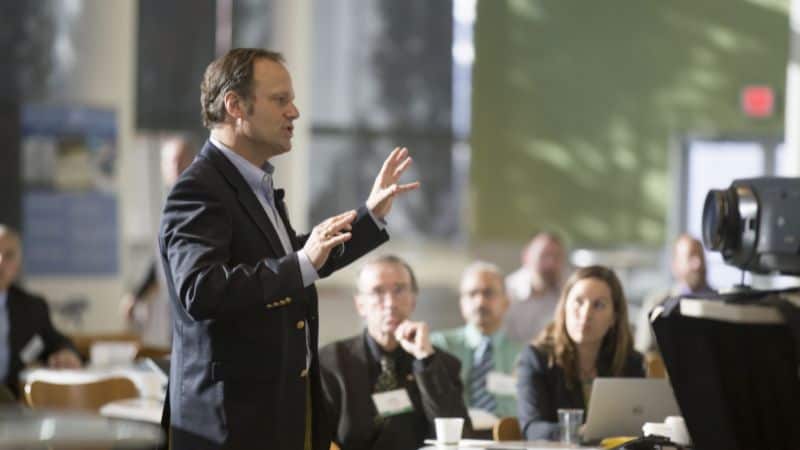Speeches to motivate are like pep talks. Just like a coach boosts a sports team’s spirits before a big game, leaders in a company use speeches to inspire their team. Leaders deliver motivational speakers to make everyone excited and focused on their jobs.
Speeches to motivate help everyone see the big picture. Imagine working without knowing the end goal—it can feel pointless. But when a leader shares their vision and the big goals of the company, it becomes clear. Everyone knows where they’re headed, and it feels good to be part of something bigger.
As a professional speaker with over 20 years of experience and a Distinguished Toastmaster (DTM), I’ve delivered motivational speeches in schools, companies, and communities across the Philippines.
Want a speech designed for your team? Learn about my motivational speaking services here →
What Are Motivational Speeches?
A motivational speech is more than a set of inspiring words. It is a message that meets people where they are—often tired, doubtful, or stuck—and helps them see a new possibility for themselves.
Unlike ordinary talks that only inform, a motivational speech is designed to move. It stirs emotions, shifts perspective, and points people toward action. The goal is not just to feel good but to do good.
When done well, a motivational speech becomes a spark. It reminds people of their strengths, renews their hope, and gives them the courage to take the next step.
Why Motivational Speeches Work
People don’t always act because they know what to do. Often, they need a push—something that awakens energy and confidence inside them. That’s where motivational speeches come in.
A good speech connects to emotions. It reminds people of what matters most, clears away doubts, and makes action feel possible again. In a few minutes, the right words can change how someone sees themselves and their situation.
Motivational speeches work because they don’t just talk about change—they help people feel it. And when people feel deeply, they are more likely to take the step forward.
Examples of Motivational Speeches
History is full of words that moved people into action. Martin Luther King Jr.’s “I Have a Dream” speech painted a vision of equality that stirred a generation. Winston Churchill’s wartime speeches gave courage to a nation under threat.
In the Philippines, Ninoy Aquino’s words—“The Filipino is worth dying for”—continue to echo in our hearts. Even in schools and workplaces, simple speeches that affirm dignity and hope can lift spirits and inspire people to keep going.
What makes these speeches memorable is not their length, but their power to speak to the human spirit and call people to rise.
Deliver Motivational Speeches
You can deliver speeches that motivate employees. It doesn’t take years of experience or a gift for public speaking. All it takes is understanding, empathy, and a clear message.
First, know your audience. Understand what drives your employees, what challenges they face, and what aspirations they hold. Connect with their experiences so your words will resonate more deeply with them.
Second, share stories. Narratives have a unique power to inspire. It could be tales of past struggles that led to success or stories of ordinary people achieving extraordinary things. These real-life examples can provide hope, teaching your team that they too can overcome obstacles and achieve greatness.
Next, be genuine. Employees can sense when words are insincere. Speak from the heart. Let your passion for the company’s goals shine through your words. Your genuine commitment can inspire similar feelings in your team.
Finally, encourage feedback. After your speech, open the floor for questions, or create avenues for feedback. This two-way communication not only shows that you value their opinion but can also provide insights on areas of improvement for future speeches.
Leaders can use motivational speeches to encourage and equip people. Motivational speeches aren’t just about stringing together uplifting words. They’re about creating a bond, fostering a shared vision, and lighting a fire of passion and purpose in every member of your team.
So, step up to that podium with confidence, because with the right intent and preparation, you indeed can inspire and lead your team to greatness.

Elevate Your Team with the Motivational Speaker Bootcamp! 🎙️
Imagine your supervisors and managers inspiring teams just like the world’s top motivational speakers. With our Motivational Speaker Bootcamp, it’s not just a dream. Tailored specifically for leaders, our program transforms regular communicators into powerful orators.
Elevate your supervisors and managers to motivate, inspire, and drive results through the art of compelling speech.
Want to see a ripple effect of motivation throughout your organization? It starts at the top. Equip your leaders with the skills to uplift and energize. Discover more about the Motivational Speaker Bootcamp for your team.
Below, you will find examples of short motivational speeches. Study how each one is structured.
Speeches to Motivate Employees
Speeches to motivate is an important leadership tool. With so much happening around us, it’s easy to feel lost or overwhelmed. A great speech can be like a compass, pointing everyone in the right direction and reminding them that together, they can tackle any challenge.
Setbacks are the Pillars of Success
In every company, from the most renowned to the startups, there’s a common thread – the pursuit of success. We launch projects with high hopes, invest countless hours, and dream of the results.
Yet, sometimes, despite all the effort, things don’t go according to plan.
Our projections fall short, our strategies falter, and we’re left grappling with unexpected outcomes. It’s like preparing for months for a marathon, only to stumble a few miles in. It’s disheartening and can often feel like all our efforts were in vain.
And this is where doubt sneaks in, whispering in our ears. “Maybe this isn’t for you,” it suggests. “Perhaps you weren’t cut out for this challenge after all.” These whispers grow louder, overshadowing our initial enthusiasm and causing morale to dip. The allure of playing it safe beckons.
Why risk when the possibility of failure looms so large?
But it’s not just about the fear of failure. It’s the weight of expectations from peers, superiors, and most crucially, ourselves.
Often, we become our harshest critics, perceiving every setback as a reflection of our capabilities. The real tension surfaces in the battle between our aspirations and the daunting challenges ahead.
However, it’s in these moments of tension that growth happens. Amidst the storm, we uncover our true potential.
Imagine if, with every stumble, we took a moment to understand why. Each hiccup becomes a lesson, a guide spotlighting where we need more focus and which skills require honing. Through these valuable insights, we edge closer to success.
So, the next time we encounter a setback, let’s not view it as a terminus. Instead, see it as an opportunity to pivot, recalibrate, and redirect. Remember, in our professional odysseys, it’s these very setbacks, these formidable challenges, that carve the path to our success stories.

The Secret Weapon in a Changing World
It’s no longer enough to rest on past achievements or traditional methods of operation. The game has changed, and the rules are constantly being rewritten. In this ever-shifting landscape, one tool stands out as the ultimate differentiator: continuous learning.
Imagine a world where the knowledge you acquired in school or college is the only knowledge you’ll ever have. Static, unchanging, and eventually obsolete.
That’s a world many of us grew up in, where education had a start and an end.
But as the pace of change has accelerated, this model has shown its limitations. Today’s breakthroughs are tomorrow’s ancient history, and the skills we consider cutting-edge now may be redundant in just a few years.
This is where continuous learning comes into play, acting as our secret weapon.
It’s the driving force that ensures we remain relevant, competitive, and ahead of the curve. More than just a tool for professional development, continuous learning shapes our perspective, refines our adaptability, and fuels our innovation.
It keeps us curious, engaged, and ever-ready to tackle the challenges of tomorrow.
However, continuous learning isn’t just about attending workshops or pursuing additional degrees. It’s a mindset, a commitment to seeking knowledge every day, in every experience. It’s about being open to new ideas, questioning the status quo, and being willing to unlearn outdated practices to embrace new, more efficient ones.
Our greatest asset is our ability to change with the world.
So, as the world around us continues to evolve at breakneck speeds, let’s arm ourselves with the most potent weapon available. Let’s commit to continuous learning, not just as a practice but as a lifestyle. In doing so, we’re not just preparing ourselves for the future; we’re actively shaping it.
Overcoming Impostor Syndrome
Have you ever felt like you didn’t deserve a compliment at work? Like when your boss praised you for a job well done, but you brushed it off, thinking anyone could have done it? That’s called Impostor Syndrome, and it’s like a sneaky voice in your head telling you that you’re not as good as people think you are.
Think of Sarah from accounting. She worked hard on a report for weeks. When it was done, everyone said it was brilliant. But instead of feeling proud, Sarah thought they were just being nice or that she just got lucky this time. That’s Impostor Syndrome in action.
Or consider Mike from marketing. He gave a presentation that everyone loved. They called it creative and insightful. But Mike? He believed he just had good slides, and anyone with those slides would have done just as well. That sneaky voice was telling Mike that he wasn’t special; his tools were.
But here’s the thing: Just knowing about Impostor Syndrome is half the battle. Once you spot it, you can challenge that voice. You can start owning your achievements. That means when you do a great job, believe it’s because of your effort and skill, not just luck or good timing.
Let’s help Sarah and Mike. Sarah needs to remember all those late nights she spent perfecting that report. It wasn’t luck; it was her dedication. Mike should recall how he researched for that presentation, and how he chose each slide carefully. It wasn’t just the slides; it was his hard work.
For all of us, whenever we hear that doubting voice, we should remind ourselves of the effort we put in. Keep a list of your successes at work, big or small. Look at it when you’re feeling unsure. Talk to your co-workers; they often see our value more clearly than we do.
In short, Impostor Syndrome might visit us now and then, but we don’t have to invite it to stay. By recognizing our hard work and valuing our achievements, we can show that sneaky voice the door and truly appreciate the work we do.
Work-Life Balance
Have you ever felt overwhelmed juggling work tasks while also trying to manage your personal life? Like when you’re staying late at the office for the third time this week, missing another of your kid’s soccer games or that dinner date with friends? Some people say achieving a perfect work-life balance is just a dream, like finding a unicorn.
But is it really?
Think of Ramon from the sales department. He’s always on his phone, answering emails even during family dinners. His kids often complain they don’t see him enough, and he feels he’s missing out on their growing up. That’s the struggle for work-life balance showing up loud and clear.
Then there’s Lisa from HR. She’s managed to set strict boundaries. She logs off at 5 PM sharp and dedicates her evenings to her family and hobbies. On weekends, her work phone stays in a drawer. Some might say Lisa has found the elusive balance, but she’ll tell you it took effort and setting clear priorities.
So, is perfect balance a myth? Maybe. Life is unpredictable, and sometimes work will need more attention, and at other times, family or personal life will take the front seat. But, with intention and boundaries, a better balance can be an attainable reality.
Here’s a tip: Like Ramon could try scheduling quality family time in his calendar, just as he would a business meeting. By respecting that time, he ensures he gives his family the attention they deserve. And Lisa? She can be a role model for others, showing it’s okay to set limits with work to protect personal and family time.
Set boundaries and priorities. While a perfect work-life balance might be a moving target, achieving a balance that works for you is possible.
Remember, it’s not about perfection, but about making choices that align with your values and what’s important to you.
So, while the unicorn of perfect balance might remain elusive, a more balanced, fulfilling life is definitely within reach.

Every Task Matters: Finding Purpose in Work
It’s easy to feel lost in the vast machinery of modern work culture. Daily tasks might sometimes seem trivial, even insignificant, against the backdrop of a massive organization or the grand tapestry of history. However, it’s crucial to remember that every role, no matter how small, plays a part in the bigger picture. Every task is a note in a symphony, and when played with purpose, it creates harmonious music.
Helen Keller once said, “I long to accomplish a great and noble task, but it is my chief duty to accomplish small tasks as if they were great and noble.”
Now, consider her story. Born deaf and blind, Keller could have been overwhelmed by the limitations imposed on her. Instead, with determination and the help of her teacher Anne Sullivan, she learned to communicate, later becoming an accomplished author, political activist, and lecturer.
Each small step in her journey had a purpose and led to her incredible achievements.
Think of John from the mailroom. Day in and day out, he sorts and delivers letters and packages. To some, it might seem mundane, but to John, every parcel delivered timely means someone gets the information or tools they need to do their job effectively. In this way, John plays a vital role in keeping the communication flowing and the organization running smoothly.
Similarly, Jane, a receptionist, might be the first point of contact for visitors. Her smile, her efficiency, and her warmth can shape the first impressions of the company. Every call she transfers, every guest she welcomes, she does with the understanding that she’s setting the stage for successful interactions.
Taking inspiration from Helen Keller, it’s important to approach every task, no matter how small, with a sense of purpose. Realizing that every duty is interconnected and contributes to a greater goal can infuse our daily routines with meaning and motivation.
In closing, always remember that significance isn’t reserved only for grand gestures or major milestones. The smallest tasks, when done with purpose and dedication, can ripple out, creating waves of positive impact. So, as you go about your day, take pride in the knowledge that every task matters and that you’re playing a vital role in the broader tapestry of progress.
How Optimism Fuels Success
How we choose to view challenges, setbacks, and opportunities can deeply influence our trajectory. While the road to success is seldom smooth, adopting a positive outlook can not only make the journey more pleasant but can also expedite our arrival at our desired destination.
Winston Churchill, a man who faced immense challenges and led Britain during its toughest times, aptly said, “A pessimist sees the difficulty in every opportunity; an optimist sees the opportunity in every difficulty.” His leadership during World War II wasn’t just about strategy; it was underpinned by an unyielding optimism. He believed in a brighter future, even in the face of dire circumstances, and his positivity galvanized a nation.
Take Alex, a project manager.
When a key project hit a snag due to supply chain issues, instead of being bogged down by the setback, he saw it as an opportunity to explore alternative suppliers and potentially better materials. His positive approach not only solved the immediate problem but also paved the way for more robust project execution in the future.
Then there’s Maya, a customer service representative.
When faced with a particularly irate customer, she chooses to see it as a chance to turn a critic into an advocate. Her optimism allows her to handle complaints with grace, listen to feedback, and make customers feel valued. With her positive attitude, what could have been a loss becomes an opportunity for improvement and growth.
Drawing from Churchill’s wisdom and the examples set by individuals like Alex and Maya, we see that optimism isn’t just a feel-good mindset; it’s a powerful tool for success.
By cultivating positivity, we not only brighten our own days but also open doors to solutions, innovations, and opportunities that might remain hidden to a more pessimistic eye.
Let’s make positivity our trusted companion. By doing so, we’re not just hoping for a better outcome; we’re actively paving the way for it.
Optimism, in essence, becomes the fuel that drives us forward, turning challenges into stepping stones and propelling us toward greater success.
Keep Yourself Motivated
Every day, we face a blend of opportunities, challenges, routines, and unexpected twists. Amidst this mix, one’s inner drive – motivation – acts as the compass that keeps us moving forward, even when the terrain gets tough. Keeping that motivation alive and burning is not just an art, but also a discipline.
So, how can we nurture it and ensure it remains our constant?
First, consider the story of Thomas Edison. When inventing the light bulb, he encountered thousands of failures. Yet, he once remarked, “I have not failed. I’ve just found 10,000 ways that won’t work.” Edison’s perspective showcases the spirit of seeing setbacks not as failures but as lessons. This approach fueled his motivation and eventual success.
Drawing from such wisdom, let’s begin by setting clear goals.
Think of Jake, a young entrepreneur. By visualizing his startup’s potential growth in five years, he creates a mental roadmap that guides him. Each small achievement becomes a stepping stone, and even setbacks are seen as redirections, not roadblocks.
Celebrate small wins. Emma, a writer, understands the daunting task of penning a novel. Instead of getting overwhelmed by the entire process, she celebrates each chapter she completes. These mini milestones keep her motivated, making the larger goal feel more achievable.
Surround yourself with positivity. Alex, an artist, keeps a board filled with positive affirmations, inspirational quotes, and images of his heroes in his studio. This board serves as a daily reminder of his purpose and fuels his drive, especially during creative slumps.
Seek feedback and continuously learn. Mia, a software developer, knows the tech world is ever-evolving. She stays motivated by constantly updating her skills and seeking feedback. Every new piece of knowledge becomes a tool, making her journey more exciting and purposeful.
Lastly, remember the power of taking breaks and self-care. Carlos, a teacher, understands the importance of rejuvenation. After intense weeks of lesson planning and teaching, he ensures he takes short breaks, meditates, or goes for walks. These moments of pause recharge his motivational battery.
Motivation isn’t magic; it’s a flame that we must tend to.
By setting clear visions, celebrating progress, surrounding ourselves with inspiration, continuously learning, and prioritizing self-care, we can ensure that our motivational flame not only stays lit but burns brighter with each passing day.

Travel Light in Life
You know that feeling when you’re on a trip, and halfway through, you realize you’ve packed way too much? Your suitcase is bursting, and you’re lugging around stuff you don’t even need. Life can feel a lot like that sometimes.
We carry around old memories, grudges, and fears that just weigh us down.
The cool part? We can choose to let go of this baggage, making our journey a whole lot lighter and more fun.
Have you heard of Bruce Lee? Besides being a famous movie star and martial artist, he had a neat way of looking at things. He said something like, “Don’t add more, just remove the stuff you don’t need.” It’s like cleaning out a cluttered room.
You get rid of the junk and suddenly, there’s so much more space to dance around!
Think about Anna. She’s a writer who kept every single note, draft, and paper she ever wrote. Her desk was a mountain of paper. One day, she decided to tidy up. She kept only the essentials and got rid of the rest.
Her mind felt clearer, and her writing flowed better.
Then there’s Ben. He’s a musician who once got turned down by some big-shot music folks. That hurt. And he kept playing those rejections in his head like a broken record. But the moment he decided, “Enough of this! I’m moving on,” he felt free and made even better music.
So, what’s the lesson here?
Letting go doesn’t mean throwing away everything or forgetting your past. It’s about getting rid of the stuff that’s holding you back. Think of it as spring cleaning for your life.
Want to feel lighter? Happier? More free?
Start letting go of the stuff you don’t need. It might be tough at first, but trust me, once you start, it gets easier. And the best part? Life becomes a whole lot more exciting when you’re not weighed down. So, ready to start traveling light?
Stand Up Without Tearing Down
Ever been in a situation where you wanted to say something but bit your tongue? Or maybe you blurted something out and later thought, “Oh, why did I say that?” We’ve all been there. The trick is to find that sweet spot between being a doormat and a bulldozer.
That sweet spot is assertiveness.
Think of it like this: Imagine you’re at a buffet. There’s that last piece of pie, and both you and another person reach for it at the same time. Being passive is like saying, “Oh, you can have it,” even if you really wanted it. Being aggressive is like grabbing it and saying, “I saw it first!” But being assertive? That’s like saying, “Hey, I’d really like to have this pie. How about we split it?”
Martin Luther King Jr., a hero to many, once said, “The ultimate measure of a man is not where he stands in moments of comfort, but where he stands at times of challenge and controversy.”
He stood up for what he believed in, but he always preached non-violence. He was assertive, not aggressive.
Consider Lisa from accounting. She had an idea to make the monthly report way easier to read. Instead of staying quiet in the meeting, she confidently shared her idea without putting down the old method. And guess what? Everyone loved it!
Then there’s Raj, a team leader. He had to guide his team but didn’t want to be bossy. Instead of giving orders, he’d discuss tasks, making sure everyone was heard. He stood up for his team’s needs without tearing anyone down.
Being assertive is all about balance. It’s standing up for yourself, but also respecting others. It’s about speaking your truth without shutting down someone else’s.
To put it simply, assertiveness is like playing a team sport. You want to score, but you also want to play fair.
So next time you’re faced with a situation where you need to take a stand, remember: It’s completely possible to stand tall without pushing anyone else down.
Ready to give it a shot?
The Pursuit of Excellence, Not Perfection
Ever tried drawing a perfect circle freehand? Pretty tough, right? That’s a lot like life. Chasing “perfect” can sometimes lead us down a frustrating rabbit hole.
But aiming for excellence? Now that’s a game-changer. It’s about giving your best shot, not about being flawless.
Let’s break it down with a simple story.
Picture this: Emma’s baking a cake for her friend’s birthday. She wants it to be perfect. Every time there’s a tiny flaw – maybe a bubble on the icing or a slightly uneven layer – she starts over. Hours go by. Her kitchen is a mess. By the time she gets it “perfect”, she’s exhausted, and the party’s almost over.
On the other hand, there’s Jake. He’s also baking a cake, but he’s not stressing over perfection. He wants it to taste amazing and look good. There might be a few hiccups along the way, but he rolls with them, maybe even turns them into a fun design twist. He finishes with plenty of time to spare, feeling proud and excited to share his creation.
The difference? Emma was chasing perfection and got bogged down in the details. Jake aimed for excellence and enjoyed the process.
Remember the saying, “Practice makes perfect?” Well, a better twist might be, “Practice makes progress.” The idea is to grow, learn, and improve, not to attain some mythical state of perfection.
Think of your favorite sports star or musician. They didn’t get to where they are by being perfect every time. They messed up, learned, adjusted, and kept pushing forward. They aimed for being the best they could be, not for being perfect.
So, the next time you catch yourself getting caught up in the perfection trap, take a step back. Ask yourself: “Am I giving my best? Is this making me happy?”
Remember, life’s a journey. It’s about growing, enjoying, and striving for excellence. Leave the pursuit of perfection behind, and embrace the joy of the journey.
Because in the end, it’s the experiences, learnings, and memories that truly matter, not some unattainable ideal of perfection.

Reinvent Yourself Every Day
Imagine waking up every morning with the idea that today, you get a fresh start. Not in a “move-to-another-country-and-change-your-name” kind of way, but in small, meaningful shifts that let you evolve.
This is the beauty of reinventing yourself daily. It’s not about changing who you fundamentally are, but about allowing yourself the freedom to grow and adapt, one day at a time.
Consider Sarah, an artist. For years, she painted only landscapes. It’s what she was known for, and she was good at it.
But one day, she felt the urge to try abstract. The first few attempts? Not what she expected. They didn’t look “right” to her. But rather than giving up, she painted a new piece every day, each one different from the last. With each stroke, she was reinventing her style, her perspective, her voice.
Then there’s Miguel. He was a high school teacher who started each day with a simple question: “How can I teach one concept in a new way today?” Some days he’d use music, other days stories or even puzzles. This daily reinvention kept his classes fresh and engaging, not just for his students, but for himself as well.
Life isn’t static.
We’re not meant to stay in one place, doing things the same way over and over. Each day offers a new opportunity, a blank canvas. It might be as simple as trying a new food, picking up a different book genre, or even taking a different route to work.
Ever heard the saying, “You can’t teach an old dog new tricks”? Well, humans aren’t dogs. We’re built for adaptation, for learning, for growth. Each morning is a new chapter, a fresh start.
So, challenge yourself: What’s one small thing you can do differently today? How can you reinvent, reimagine, or rejuvenate even a tiny aspect of your life? Embrace this daily evolution. Because by reinventing yourself in little ways every day, you’re not discarding the old, but enhancing, enriching, and adding layers to the beautiful tapestry of who you are. Remember, every sunrise is an invitation to a fresh start.
Are you ready to RSVP?
Your Attitude Determines Your Altitude
Have you ever watched a bird take flight? It begins on the ground, focused and determined, then flaps its wings, catching the wind, and soars. Just like that bird, where we go in life is often determined by our mindset.
Our attitude acts as the wind beneath our wings; the right one can take us to incredible heights.
Picture Jamie, a sales rep in a tech firm.
Two years in, she faced a month where she just couldn’t make a sale. She had two choices: slump into negativity or adjust her attitude. Instead of lamenting her streak of rejections, Jamie decided to view them as lessons. She sought feedback, adapted, and used each “no” as a stepping stone.
That change in attitude? It became her wind, propelling her upwards, and by the end of the following month, she had not only met but surpassed her targets.
Now, think about Leo, a school coach.
His team wasn’t the strongest; in fact, they’d lost more matches than they’d won. But Leo believed in the power of a positive mindset. He constantly told his team, “Every game is a new opportunity.” With his encouragement, the team began to focus not on the fear of losing but on the thrill of playing. Their attitude shift transformed their performance. They might not have won every game, but they played with heart and passion, making every match memorable.
Our journey in life is filled with ups and downs. While we might not control every event, we do have control over our reactions. Think of it like flying a kite. Sometimes the wind is against you, sometimes it’s with you, but how high the kite flies depends on how you maneuver it.
A quote often attributed to Zig Ziglar says, “Your attitude, not your aptitude, will determine your altitude.” It means that it’s not just our skills or talents that decide how far we’ll go, but our mindset and approach.
So, if you ever find yourself grounded by challenges, remember: the power to soar lies within you. Adjust your attitude, spread your wings, and let the winds of positivity lift you to heights you’ve never imagined.
After all, the sky isn’t the limit; it’s just the beginning.
Ready to take flight?
How to Craft Speeches That Motivate
I used a straightforward method to shape these speeches: begin with a situation, delve into the struggle, and then highlight the success. Each speech weaves in stories, quotes, and examples to make the message stick. When leaders use this approach, they can craft speeches that truly motivate their teams.
Now, let’s break down how to use the “situation, struggle, success” pattern:
- Situation: Start with a relatable scenario or setting. This could be a common challenge, a shared experience, or an observation. It sets the stage and draws your listeners in.
- Struggle: Here’s where you dive into the problem or conflict. Share stories or examples that highlight the tension or challenge. This part is crucial as it builds empathy and keeps your audience engaged, wanting to know the outcome.
- Success: Conclude by showcasing the resolution or triumph. Share the lessons learned, the achievements gained, or the insights discovered. This leaves your audience with a sense of hope, inspiration, or a clear takeaway.
By following this simple structure, you’ll be on your way to delivering impactful and memorable speeches.
Give it a try!
Motivational Speeches of Famous People
We can also learn how to deliver speeches that motivate by studying the speeches of famous people. I recommend that you watch these videos and explore the techniques applied.
Steve Jobs’ 2005 Stanford Commencement Address
Steve Jobs’ 2005 Stanford Commencement Address is one of the most iconic motivational speeches of the 21st century. Here are five invaluable lessons employees can glean from it:
- Connecting the Dots: Jobs spoke about how we can only connect the dots looking backward, not forward. This teaches us the importance of trust in our journey, even if we don’t know where it will lead. Every experience, even those that seem inconsequential, can play a vital role in shaping our future.
- Love What You Do: Steve emphasized the significance of passion and perseverance. “The only way to do great work is to love what you do,” he said. For employees, this underscores the importance of seeking work that aligns with their passion or finding passion in the tasks they do.
- Death as a Motivator: Jobs mentioned that remembering he’d be dead soon helped him make the big choices in life. While this might seem morbid, the lesson is clear: Life is short. This perspective encourages employees to not waste time on trivialities but to focus on what truly matters and pursue their goals with urgency.
- Stay Hungry, Stay Foolish: This memorable line from the speech encourages continuous learning and curiosity. Employees can take this as a cue to always seek knowledge, be open to new experiences, and not settle into complacency.
- Overcoming Setbacks: Jobs shared his experience of being fired from Apple, the company he started. Instead of giving up, he saw it as an opportunity to begin again, leading to some of his most creative innovations. This teaches employees resilience and the importance of viewing challenges or setbacks as opportunities for growth.
In essence, Steve Jobs’ address serves as a reminder of the unpredictable nature of life, the importance of passion, and the immense potential every setback holds if approached with the right mindset.
Steve Jobs was a masterful communicator, and his 2005 Stanford Commencement Address showcased many of his signature speaking techniques. Here’s an analysis of some techniques he employed in this particular speech:
Storytelling
One of the most notable aspects of the speech is Jobs’ use of personal anecdotes. He structured his address around three stories from his life. This narrative approach made his speech more relatable and memorable, allowing listeners to connect with him on a personal level.
Simple and Clear Language
Jobs was known for making complex ideas accessible. In this speech, he used plain language, avoiding jargon, which made his messages clear and resonated with a broad audience.
Emotionally Resonant Content
Jobs tapped into universal themes like love, loss, and death. By discussing his cancer diagnosis and his feelings about mortality, he connected emotionally with his audience, making his words more impactful.
Pacing and Pauses
Throughout the speech, Jobs employed a deliberate pacing, using pauses effectively. This allowed his audience to absorb each point before moving on to the next, and it added gravitas to his words.
Repetition for Emphasis
Jobs often repeated key phrases or ideas for emphasis. For instance, the repeated reference to “connecting the dots” underscored its importance and made the concept more memorable.
Engaging Opening
He began his speech with a candid admission, “I never graduated from college,” immediately capturing the attention of his university audience. This humble and unexpected opening set the tone for the rest of his address.
Concluding with a Strong Message
Jobs wrapped up his speech with the memorable advice, “Stay Hungry. Stay Foolish.” By ending on this powerful note, he left his audience with a clear and motivating takeaway.
These techniques, combined with Jobs’ authentic delivery and his undeniable charisma, made his Stanford address not only informative but also deeply inspiring. It’s a testament to how effective communication isn’t just about what is said, but also how it’s said.
Matt Damon’s full commencement address at MIT
Matt Damon’s commencement address at MIT in 2016 offers a blend of humor, sincerity, and thought-provoking insights. Here are four key lessons employees can take away from that speech:
- Challenge the Status Quo: Damon emphasized the importance of questioning established norms and beliefs. He encouraged the graduates not to blindly accept things as they are but to challenge and critically evaluate them. For employees, this means not being afraid to voice out concerns, suggest improvements, or bring innovative ideas to the table.
- The Power of Collaboration: Speaking at an institution renowned for science and technology, Damon highlighted the importance of blending technical prowess with empathy and collaboration. He asserted that real progress happens when diverse perspectives come together. In a workplace setting, this underscores the significance of teamwork, cross-functional collaboration, and the merging of varied skills for holistic solutions.
- Social Responsibility: Damon, known for his activism and humanitarian efforts, reminded the audience of their responsibility to address global challenges. He spoke about the importance of using one’s skills and education to make positive impacts in the world. Employees can translate this into corporate social responsibility, ensuring that their roles or the businesses they are part of contribute positively to society.
- Stay Grounded: Amidst all the achievements and accolades, Damon’s speech had an undertone of humility. He shared anecdotes that highlighted the importance of remembering one’s roots and staying grounded. For employees, this lesson serves as a reminder to remain humble, irrespective of their accomplishments, and to value every team member’s contribution.
Damon’s address, while specifically tailored for MIT graduates, carries universal lessons about responsibility, innovation, collaboration, and humility that are applicable to professionals across all fields.
Matt Damon, in his MIT commencement address, showcased a combination of eloquence, humor, and authenticity, resonating deeply with his audience. Here are some of the speaking techniques he employed:
Humor and Self-Deprecation
One of Damon’s strengths is his ability to weave humor into serious topics. He used self-deprecating jokes, especially about his lack of a degree or being just an actor, to connect with the audience, break the ice, and keep the mood light.
Anecdotes
Much like Steve Jobs, Damon incorporated personal stories and experiences into his speech. These anecdotes made his message more relatable and memorable, grounding abstract ideas in real-world contexts.
Rhetorical Questions
Damon posed questions to his audience, prompting them to think deeply about the issues he raised. This interactive technique encourages self-reflection and keeps the audience engaged.
Direct Address
He often spoke directly to the graduates, making his speech feel more intimate and personal. By specifically acknowledging his audience (“You are the MIT graduates”), he built a bridge between himself and the listeners.
Varied Tone
Damon masterfully fluctuated between humor, sincerity, and urgency. This variation in tone ensured that the audience was constantly engaged and that his serious points were underscored with the gravity they deserved.
Reference to Current Events
Damon referenced contemporary challenges and issues, making his speech timely and relevant. By grounding his address in the present, he emphasized the immediacy and relevance of his messages.
Closing on an Inspiring Note
Damon concluded his speech by reminding graduates of their potential and the positive change they could bring to the world. Ending on an uplifting and motivational note left a lasting impression on the audience.
Through these techniques, Damon crafted a speech that was not only engaging and entertaining but also deeply meaningful, urging the audience to consider their roles in shaping the future.
Denzel Washington – University of Pennsylvania
Denzel Washington delivered a memorable commencement address at the University of Pennsylvania in 2011. From his heartfelt words, employees can derive several valuable lessons. Here are three key takeaways:
- Fail Big and Embrace Risks: One of the central themes of Washington’s speech was the idea of taking risks and not being afraid to fail. He stated, “Don’t be afraid to fail big, to dream big, but remember, dreams without goals are just dreams.” In the corporate world, this translates to the importance of setting ambitious targets, pursuing innovative ideas, and embracing challenges, even if there’s a risk of failure. It’s through daring endeavors and learning from failures that real growth occurs.
- Consistency and Hard Work: Washington emphasized that “every day is not a success, every year is not a success.” But he stressed the importance of putting in hard work consistently. He mentioned the need for discipline and commitment to achieving one’s goals. For employees, this is a reminder that while there might be days of struggle, persistence and consistency will eventually yield results.
- Gratitude and Giving Back: Washington urged graduates to remember to give back. He said, “At the end of the day, it’s not about what you have or even what you’ve accomplished… It’s about who you’ve lifted up, who you’ve made better.” In the workplace, this translates to the importance of mentorship, helping colleagues, and building an environment of mutual growth. It’s a reminder for employees to not just focus on personal success but also on how they can uplift others and contribute to the larger community.
Denzel Washington’s speech at Penn was not only inspirational for the graduates but also serves as a beacon of wisdom for professionals in any field, emphasizing the values of ambition, perseverance, and altruism.
Denzel Washington’s commencement address at the University of Pennsylvania showcased his skill as an orator. Here are three speaking techniques he employed during the speech:
Personal Anecdotes
Washington infused his speech with personal stories from his life, like his experiences in college and his early career struggles.
By sharing these anecdotes, he humanized himself, allowing the audience to see their own challenges reflected in his journey. These stories served as both testimonials to his advice and as tools to forge a deeper connection with his listeners.
Rhythmic Repetition
Much like great orators, Washington used repetition as a tool to drive home his key messages. By repeating certain phrases, he emphasized their importance and made them more memorable for his audience.
An example from his speech is, “Don’t be afraid to fail big, to dream big,” where repetition gives weight to the idea of dreaming and taking risks.
Engaging with the Audience
Washington made direct addresses to the graduating class, asking questions and prompting them to nod or respond.
This interactive approach kept the audience involved and engaged throughout his address. Instead of a monologue, his speech felt like a conversation, allowing the audience to feel more connected to the content and messages he was sharing.
These techniques, combined with Washington’s genuine delivery and palpable passion, made his speech impactful and resonant, leaving a lasting impression on those who heard it.







